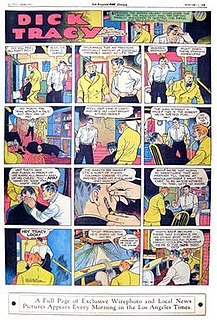
Dick Tracy is an American comic strip featuring Dick Tracy, a tough and intelligent police detective created by Chester Gould. It made its debut on Sunday, October 4, 1931 in the Detroit Mirror, and it was distributed by the Chicago Tribune New York News Syndicate. Gould wrote and drew the strip until 1977, and various artists and writers have continued it. Dick Tracy has also been the hero in a number of films, including Dick Tracy in which Warren Beatty played the lead in 1990. Tom De Haven praised Gould's Dick Tracy as an "outrageously funny American Gothic", while Brian Walker described it as a "ghoulishly entertaining creation" which had "gripping stories filled with violence and pathos".
The Space Odyssey series is a series of science fiction novels by the writer Arthur C. Clarke. Two of the novels have been made into feature films, released in 1968 and 1984 respectively. Two of Clarke's early short stories may also be considered part of the series.

Fireball XL5 is a 1960s British children's science-fiction puppet television series about the missions of Fireball XL5, a vessel of the World Space Patrol that polices the cosmos in the year 2062. Commanded by Colonel Steve Zodiac, XL5 defends Earth from interstellar threats while encountering a wide variety of alien civilisations.

2010: The Year We Make Contact is a 1984 science fiction film written, produced, shot and directed by Peter Hyams. It is a sequel to Stanley Kubrick's 1968 film 2001: A Space Odyssey and is based on Arthur C. Clarke's 1982 sequel novel, 2010: Odyssey Two. The film stars Roy Scheider, Helen Mirren, Bob Balaban and John Lithgow, along with Keir Dullea and Douglas Rain of the cast of the previous film.
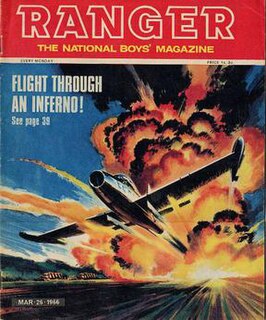
Ranger was a British comic book magazine, with occasional printed stories, published by Fleetway Publications for 40 un-numbered issues between 18 September 1965 and 18 June 1966. The title was then incorporated into Look and Learn from issue 232, dated 25 June 1966.
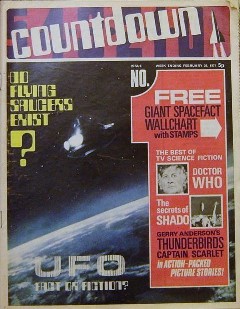
Countdown was a British comic published weekly by Polystyle Publications – ultimately, under several different titles – from early 1971 to late summer 1973. The pages in each issue were numbered in reverse order, with page 1 at the end – a gimmick which was derived from the comic's title in order to create a countdown to the number one every week.
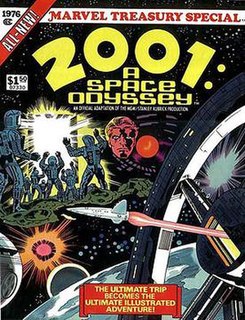
2001: A Space Odyssey is an oversized American comic book adaptation of the 1968 film of the same name as well as a ten-issue monthly series which expanded upon the concepts presented in the Stanley Kubrick film and the novel by Arthur C. Clarke. Jack Kirby wrote and pencilled both the adaptation and the series, which were published by Marvel Comics beginning in 1976. The adaptation was part of the agreement of Kirby's return to Marvel.
2001: A Space Odyssey is the 1968 science fiction novel written by Arthur C. Clarke and the 1968 film directed by Stanley Kubrick. It is a part of Clarke's Space Odyssey series, the first of four novels and two films. Both the novel and the film are partially based on Clarke's 1948 short story "The Sentinel", an entry in a BBC short story competition, and "Encounter in the Dawn", published in 1953 in the magazine Amazing Stories.
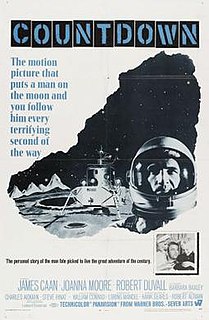
Countdown is a 1968 science fiction film directed by Robert Altman, based on the 1964 novel The Pilgrim Project by Hank Searls. Made before M*A*S*H, the film was subject to re-editing by the studio. Countdown stars James Caan and Robert Duvall as astronauts vying to be the first American to walk on the Moon as part of a crash program to beat the Soviet Union.
TV Comic was a British comic book magazine published weekly from 9 November 1951 until 29 June 1984. Featuring stories based on television series running at the time of publication, it was the first British comic to be based around TV programmes; it spawned a host of imitators.
TV Century 21, later renamed TV21, TV21 and Tornado, TV21 and Joe 90, and TV21 again, was a weekly British children's comic published by City Magazines during the latter half of the 1960s. It promoted the many science-fiction television series created by the Century 21 Productions company of Gerry and Sylvia Anderson. The comic was published in the style of a newspaper of the future, with the front page usually dedicated to fictional news stories set in the worlds of Fireball XL5, Stingray, Thunderbirds, Captain Scarlet and the Mysterons and other stories. The front covers were also in colour, with photographs from one or more of the Anderson series or occasionally of the stars of the back-page feature.
This is a list of comics regarding the Star Trek media franchise.
Ronald Turner was a British illustrator and comic book artist.
This is a list of Dalek comic strips, illustrated annuals and graphic novels. Cameo appearances and reprints are only covered if notable.

2001: A Space Odyssey is a 1968 epic science fiction film produced and directed by Stanley Kubrick. The screenplay was written by Kubrick and Arthur C. Clarke, and was inspired by Clarke's 1951 short story "The Sentinel" and other short stories by Clarke. A novel released after the film's premiere was in part written concurrently with the screenplay. The film, which follows a voyage to Jupiter with the sentient computer HAL after the discovery of an alien monolith affecting human evolution, deals with themes of existentialism, human evolution, technology, artificial intelligence, and the possibility of extraterrestrial life.

Western comics is a comics genre usually depicting the American Old West frontier and typically set during the late nineteenth century. The term is generally associated with an American comic books genre published from the late 1940s through the 1950s. Western comics of the period typically featured dramatic scripts about cowboys, gunfighters, lawmen, bounty hunters, outlaws, and Native Americans. Accompanying artwork depicted a rural America populated with such iconic images as guns, cowboy hats, vests, horses, saloons, ranches, and deserts, contemporaneous with the setting.
Brian Moncrieff Lewis was a British science fiction illustrator, comics artist, and animator. In the 1950s he illustrated covers for pulp magazines like New Worlds, Science Fantasy, and Science Fiction Adventures. In the 1960s he drew adventure comic strips for Tiger, Boys' World, Hurricane, and Eagle. He also used a more cartoony style to draw humor comic strips for Wham!, Smash, Cor!!, and Buster. In the 1970s, Lewis focused on comics adaptations of television and horror film properties.

The 1968 science fiction film 2001: A Space Odyssey featured numerous fictional future technologies, which have proven prescient in light of subsequent developments around the world. Before the film's production began, director Stanley Kubrick sought technical advice from over fifty organizations, and a number of them submitted their ideas to Kubrick of what kind of products might be seen in a movie set in the year 2001. The film is also praised for its accurate portrayal of spaceflight and vacuum.
The Doctor WhoPolystyle comic strip was the first comic strip devoted to the long-running British science fiction television series Doctor Who, and the first original spin-off media from the show. The strip was launched in TV Comic on 14 November 1964, less than a year after the television series began broadcasting. TV Comic was issued weekly, and one of a number of titles belonging to Polystyle Publications Ltd, the comic exclusively featuring strips based on television series.










